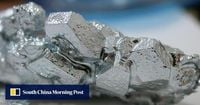In a week marked by seismic shifts in the global critical minerals landscape, governments and companies across continents are recalibrating their strategies in response to new export controls, market volatility, and geopolitical tensions. From the heart of Africa to the steppes of Central Asia and boardrooms in Europe and North America, the race for resources like cobalt, antimony, lithium, and rare earths is intensifying—and the stakes have never been higher.
On October 16, 2025, the Democratic Republic of Congo (DRC) will officially lift its seven-month-long ban on cobalt exports, as reported by China Global South Project. But this is no return to business as usual. The DRC, which remains the world’s largest cobalt producer, is replacing its blanket ban with a quota system, allowing shipments of up to 18,125 tons of cobalt for the remainder of 2025 and an annual total of 96,600 tonnes in 2026 and 2027. This quota, less than half of what the DRC exported in 2024, is expected to tighten global supply and push cobalt prices higher. The move is already sending ripples through the electric vehicle and battery industries, which rely heavily on DRC cobalt.
Why the sudden policy shift? According to China Global South Project, DRC’s government is seeking to assert greater control over its mineral wealth while responding to international pressure and domestic economic needs. The new system is designed to both increase state revenues and reduce the volatility that rocked the sector during the ban. Yet, this tightening also forces major multinational investors to reconsider their bets on Congolese cobalt. Companies are now eyeing alternative sources, particularly Indonesia, which has ramped up cobalt production in recent years.
Meanwhile, in a development that could further reshape the DRC’s mining landscape, Swiss-based Glencore is in talks to sell its 75% controlling stake in Kamoto Copper Company (KCC), a major copper-cobalt operation in the region. Prospective buyers include Orion Resource Partners and mining giant Rio Tinto, according to China Global South Project. While this could open the door for Western companies to gain a foothold in the DRC, analysts caution that the country’s reputation as a risky mining destination might limit U.S. interest. American firms often balk at the billions required for such investments, especially given ongoing concerns about governance and security.
Even if a Western company did secure the KCC stake, the challenge of refining and processing cobalt would remain. The U.S. and Europe still depend on China for much of the world’s cobalt refining capacity, underscoring the urgency of “friend-shoring”—the push to shift critical supply chains toward allied or more stable jurisdictions.
China, for its part, is not sitting idle. In fact, it is tightening its grip on another critical mineral: antimony. Over the past year, Tajikistan has emerged as the world’s second-largest exporter of antimony ore, trailing only China. This surge is thanks largely to China-backed joint ventures, such as the Saritag mine, which have propelled Tajikistan’s exports to over 4,300 tonnes in the first nine months of 2024. As China Global South Project notes, this expansion allows China to strengthen its monopoly on antimony by boosting production abroad while simultaneously restricting exports at home.
The implications are clear: as China deepens its control over antimony and other strategic minerals, Western and Japanese companies face new hurdles in securing reliable supplies. Tajikistan’s governance risks and China’s export restrictions mean that building alternative supply chains will be neither quick nor easy.
These concerns were underscored on September 27, 2025, when China’s Ministry of State Security issued a blunt warning about foreign efforts to circumvent its export controls on rare metals. According to South China Morning Post, the ministry revealed two recent antimony smuggling cases: one involving a family-run criminal network and another a group of traffickers. Eight suspects were arrested and now face prosecution for attempting to smuggle high-purity antimony ingots. The ringleader, based overseas, coordinated with domestic producers and used third-party shell companies to move the goods through a third country before final delivery. As the ministry put it, “Certain foreign countries, in an effort to expand their reserves of rare metals such as antimony, have sought to circumvent China’s export controls in order to obtain our scarce strategic resources. Such actions have already posed a real threat to China’s national security and interests.”
This warning highlights the growing tensions and clandestine maneuvers in the global resource race. With China imposing restrictions on antimony, rare earths, gallium, and germanium, attempts to bypass these controls are likely to increase, raising the risk of further diplomatic and legal clashes.
Against this backdrop, Western governments are scrambling to reduce their dependence on foreign—especially Chinese—supplies. In the United States, the Department of Energy is currently in talks with Canadian company Lithium Americas for a $2.26 billion loan to develop the Thacker Pass lithium mine in Nevada. The negotiations also include a possible 5% to 10% equity stake for the U.S. government in the company. As China Global South Project reports, this would mark a significant shift: the U.S. is now openly considering direct ownership in a critical minerals project as part of its broader push to counter China’s near-monopoly over lithium processing and refining. While America still lacks large-scale refining capacity, securing domestic raw material production is seen as a crucial first step.
Europe, too, is making moves to bolster its strategic autonomy. In Estonia, Canadian-headquartered Neo has opened Europe’s first large-scale rare earth magnet plant, a $75 million facility dedicated to supplying the automotive and wind energy industries. This project, enabled by targeted public funding and the EU’s Critical Raw Materials Act, aims to reduce Europe’s reliance on Chinese rare earths and magnets. The plant’s opening is a tangible sign of Europe’s determination to build end-to-end value chains within allied territories, even if the process will take time.
All these developments—DRC’s new export quotas, Glencore’s possible divestment, China’s crackdown on smuggling, and Western investments in new supply chains—reflect a world in flux. The old model of relying on a handful of countries for critical minerals is giving way to a more fragmented, competitive, and politically charged landscape. For companies and governments alike, the message is clear: diversify or risk being left behind.
As the global resource race accelerates, the next few years will test the ability of nations and industries to adapt, collaborate, and innovate. The winners will be those who can secure supply, manage risk, and navigate the new geopolitics of minerals—a challenge that’s only just beginning.




